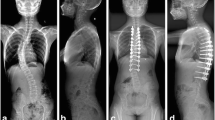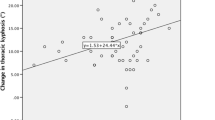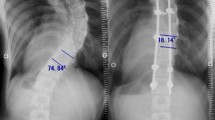Abstract
Purpose
There is still no consensus on the optimum pedicle screw density required for the desired thoracic kyphosis restoration in adolescent idiopathic surgery (AIS). The aim of this study to evaluate the effect of pedicle screw density on thoracic kyphosis restoration in AIS surgery.
Methods
The data of 106 patients from two centers that operated for Lenke type 1 and 2 AIS were retrospectively reviewed. Two groups were constituted according to the pedicle screw density: intermittent pedicle screw constructs (IPSC) (n = 52 patients) and consecutive pedicle screw construct (CPSC) (n = 54 patients) groups. The preoperative and at least 24-month follow-up radiographs and SRS-22 scores were evaluated. The Cobb angle of the main and concomitant curves in the coronal plane and the sagittal plane were measured and compared.
Results
The mean follow-up period for the IPSC and CPSC groups was 72.3 ± 37.2 and 62.9 ± 28.8 months, respectively. In the SRS-22 questionnaire, there was no significant difference between the two groups in terms of self-image/appearance domain scores (p = 0.466), but better results were obtained in the IPSC group in terms of treatment satisfaction domain scores (p = 0.010) and better thoracic kyphosis restoration was achieved in IPSC group radiologically for Lenke type 1 curves with − 81.4 ± 81.4% in the IPSC group and 6.8 ± 83.8% in the CPSC group (p < 0.001).
Conclusion
It was considered that better thoracic kyphosis restoration could be achieved with the less lordotic effect of IPSC in Lenke type 1 curves. Although the current situation had a significant impact on radiological outcomes, its effect on SRS-22 scores was limited.


Similar content being viewed by others
References
Helenius I, Mattila M, Jalanko T (2014) Morbidity and radiographic outcomes of severe scoliosis of 90° or more: a comparison of hybrid with total pedicle screw instrumentation. J Child Orthop 8:345–352. https://doi.org/10.1007/s11832-014-0604-1
Crostelli M, Mazza O, Mariani M, Mascello D (2013) Treatment of severe scoliosis with posterior-only approach arthrodesis and all-pedicle screw instrumentation. Eur Spine J 22(Suppl 6):S808-814. https://doi.org/10.1007/s00586-013-3027-7
Roussouly P, Nnadi C (2010) Sagittal plane deformity: an overview of interpretation and management. Eur Spine J 19:1824–1836. https://doi.org/10.1007/s00586-010-1476-9
Luo M, Jiang H, Wang W, Li N, Shen M, Li P, Xu G, Xia L (2017) Influence of screw density on thoracic kyphosis restoration in hypokyphotic adolescent idiopathic scoliosis. BMC Musculoskelet Disord 18:526. https://doi.org/10.1186/s12891-017-1877-6
Schmidt C, Liljenqvist U, Lerner T, Schulte TL, Bullmann V (2011) Sagittal balance of thoracic lordoscoliosis: anterior dual rod instrumentation versus posterior pedicle screw fixation. Eur Spine J 20:1118–1126. https://doi.org/10.1007/s00586-011-1784-8
Vora V, Crawford A, Babekhir N, Boachie-Adjei O, Lenke L, Peskin M, Charles G, Kim Y (2007) A pedicle screw construct gives an enhanced posterior correction of adolescent idiopathic scoliosis when compared with other constructs: myth or reality. Spine (Phila Pa 1976) 32:1869–1874. https://doi.org/10.1097/BRS.0b013e318108b912
Kuklo TR, Potter BK, Polly DW Jr, Lenke LG (2005) Monaxial versus multiaxial thoracic pedicle screws in the correction of adolescent idiopathic scoliosis. Spine (Phila Pa 1976) 30:2113–2120. https://doi.org/10.1097/01.brs.0000179260.73267.f4
Cheng I, Kim Y, Gupta MC, Bridwell KH, Hurford RK, Lee SS, Theerajunyaporn T, Lenke LG (2005) Apical sublaminar wires versus pedicle screws–which provides better results for surgical correction of adolescent idiopathic scoliosis? Spine (Phila Pa 1976) 30:2104–2112. https://doi.org/10.1097/01.brs.0000179261.70845.b7
Betz RR, Harms J, Clements DH 3rd, Lenke LG, Lowe TG, Shufflebarger HL, Jeszenszky D, Beele B (1999) Comparison of anterior and posterior instrumentation for correction of adolescent thoracic idiopathic scoliosis. Spine (Phila Pa 1976) 24:225–239. https://doi.org/10.1097/00007632-199902010-00007
Roach JW, Mehlman CT, Sanders JO (2011) Does the outcome of adolescent idiopathic scoliosis surgery justify the rising cost of the procedures? J Pediatr Orthop 31:S77-80. https://doi.org/10.1097/BPO.0b013e3181f73bfd
Lenke LG, Newton PO, Marks MC, Blanke KM, Sides B, Kim YJ, Bridwell KH (2004) Prospective pulmonary function comparison of open versus endoscopic anterior fusion combined with posterior fusion in adolescent idiopathic scoliosis. Spine (Phila Pa 1976) 29:2055–2060. https://doi.org/10.1097/01.brs.0000138274.09504.38
Kim YJ, Lenke LG, Bridwell KH, Cheh G, Sides B, Whorton J (2008) Prospective pulmonary function comparison of anterior spinal fusion in adolescent idiopathic scoliosis: thoracotomy versus thoracoabdominal approach. Spine (Phila Pa 1976) 33:1055–1060. https://doi.org/10.1097/BRS.0b013e31816fc3a5
Şenköylü A, Çetinkaya M, Daldal İ, Eren A, Aktaş E (2020) The implant density does not change the correction rate of the main and the accompanying curves: a comparison between consecutive and intermittent pedicle screw constructs. Acta Orthop Traumatol Turc 54:293–299. https://doi.org/10.5152/j.aott.2020.03.16
Larson AN, Polly DW Jr, Ackerman SJ, Ledonio CG, Lonner BS, Shah SA, Emans JB, Richards BS 3rd (2016) What would be the annual cost savings if fewer screws were used in adolescent idiopathic scoliosis treatment in the US? J Neurosurg Spine 24:116–123. https://doi.org/10.3171/2015.4.Spine131119
Shen M, Jiang H, Luo M, Wang W, Li N, Wang L, Xia L (2017) Comparison of low density and high density pedicle screw instrumentation in Lenke 1 adolescent idiopathic scoliosis. BMC Musculoskelet Disord 18:336. https://doi.org/10.1186/s12891-017-1695-x
Liu H, Li Z, Li S, Zhang K, Yang H, Wang J, Li X, Zheng Z (2015) Main thoracic curve adolescent idiopathic scoliosis: association of higher rod stiffness and concave-side pedicle screw density with improvement in sagittal thoracic kyphosis restoration. J Neurosurg Spine 22:259–266. https://doi.org/10.3171/2014.10.Spine1496
Sudo H, Abe Y, Kokabu T, Ito M, Abumi K, Ito YM, Iwasaki N (2016) Correlation analysis between change in thoracic kyphosis and multilevel facetectomy and screw density in main thoracic adolescent idiopathic scoliosis surgery. Spine J 16:1049–1054. https://doi.org/10.1016/j.spinee.2016.04.014
Larson AN, Polly DW Jr, Diamond B, Ledonio C, Richards BS 3rd, Emans JB, Sucato DJ, Johnston CE (2014) Does higher anchor density result in increased curve correction and improved clinical outcomes in adolescent idiopathic scoliosis? Spine (Phila Pa 1976) 39:571–578. https://doi.org/10.1097/brs.0000000000000204
Ketenci IE, Yanik HS, Demiroz S, Ulusoy A, Erdem S (2016) Three-dimensional correction in patients with Lenke 1 adolescent idiopathic scoliosis: comparison of consecutive versus interval pedicle screw instrumentation. Spine (Phila Pa 1976) 41:134–138. https://doi.org/10.1097/brs.0000000000001182
Clements DH, Betz RR, Newton PO, Rohmiller M, Marks MC, Bastrom T (2009) Correlation of scoliosis curve correction with the number and type of fixation anchors. Spine (Phila Pa 1976) 34:2147–2150. https://doi.org/10.1097/BRS.0b013e3181adb35d
Wang X, Aubin CE, Robitaille I, Labelle H (2012) Biomechanical comparison of alternative densities of pedicle screws for the treatment of adolescent idiopathic scoliosis. Eur Spine J 21:1082–1090. https://doi.org/10.1007/s00586-011-2089-7
Schwab F, Blondel B, Chay E, Demakakos J, Lenke L, Tropiano P, Ames C, Smith JS, Shaffrey CI, Glassman S, Farcy JP, Lafage V (2014) The comprehensive anatomical spinal osteotomy classification. Neurosurgery 74:112–120. https://doi.org/10.1227/NEU.0000000000000182o
Han S, Hyun SJ, Kim KJ, Jahng TA, Lee S, Rhim SC (2017) Rod stiffness as a risk factor of proximal junctional kyphosis after adult spinal deformity surgery: comparative study between cobalt chrome multiple-rod constructs and titanium alloy two-rod constructs. Spine J 17:962–968. https://doi.org/10.1016/j.spinee.2017.02.005
Han S, Hyun SJ, Kim KJ, Jahng TA, Kim HJ (2017) Comparative study between cobalt chrome and titanium alloy rods for multilevel spinal fusion: proximal junctional kyphosis more frequently occurred in patients having cobalt chrome rods. World Neurosurg 103:404–409. https://doi.org/10.1016/j.wneu.2017.04.031
Funding
No financial support was received from any institutions and organizations for the study.
Author information
Authors and Affiliations
Corresponding author
Ethics declarations
Conflict of interest
The authors have no relevant financial or non-financial interests to disclose. There is no conflict of interest between the authors.
Ethics approval
Ethics committee approval was obtained from Gazi University Ethics Commission for the study (Number: E-77082166-6014.01.02-438870).
Additional information
Publisher's Note
Springer Nature remains neutral with regard to jurisdictional claims in published maps and institutional affiliations.
Rights and permissions
Springer Nature or its licensor (e.g. a society or other partner) holds exclusive rights to this article under a publishing agreement with the author(s) or other rightsholder(s); author self-archiving of the accepted manuscript version of this article is solely governed by the terms of such publishing agreement and applicable law.
About this article
Cite this article
Baymurat, A.C., Yapar, A., Kilicaslan, O.F. et al. Intermittent pedicle screw application provides better kyphosis restoration in adolescent idiopathic scoliosis for Lenke type 1 and type 2 curves. Eur Spine J 32, 2213–2220 (2023). https://doi.org/10.1007/s00586-023-07669-6
Received:
Revised:
Accepted:
Published:
Issue Date:
DOI: https://doi.org/10.1007/s00586-023-07669-6




